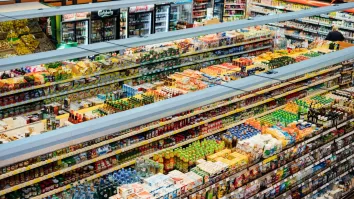Why micro-retail is the way to go to reach Southeast Asian shoppers
By Ann Gabrielle DomingoIt’s not a secret that micro-retail, especially in the form of traditional mom-and-pop stores, are still a huge part of Southeast Asia’s overall economic growth. Prevalent all across the region, these small, family-run businesses—known as sari-sari in the Philippines, warung in Indonesia, and shohuay in Thailand—usually sell groceries in sachets or other tiny packages. Most products are hung by the storefront so that customers can quickly tell what’s available for the day. Besides bagging a meagre amount of groceries, people can typically also buy snacks or drinks to go.
Despite their unassuming setups, these family-run stores are a force to be reckoned with. According to a 2023 report by Boston Consulting Group (BCG), “traditional trade” formats makeup 73% of Southeast Asia’s grocery retail market. The resiliency of these micro-retail stores came into full display after the pandemic: Whilst hypermarkets saw a 4% decline and supermarkets only grew by 2% from 2018 to 2022, smaller formats took the lead with a 7% annual growth rate within the region. Even when the month-on-month (MoM) inflation rate in the Philippines rose to 6.6% as of April 2023, sari-sari stores still achieved a MoM of 14.4%.
Supermarkets and hypermarkets, defined as “modern trade” by BCG, have actually long been aware of the staying power of micro-retail in the region, establishing their own minimarkets to reach Southeast Asian shoppers. This strategy was proven successful in the past few years: smaller formats now make up ~73% of the total modern trade market in Indonesia and ~58% in share of Thailand’s modern trade as of 2022. Whilst currently lagging behind, major retailers in other Southeast Asian countries are aiming to catch up through efforts such as the Philippines’ SM Supermarkets continued expansion of its minimart chain Alfamart.
Perhaps the most obvious reason why micro-retail stores still have a stronghold over Southeast Asia is because of the convenience they provide in a region that’s still mostly rural, thus lacking robust infrastructures for electricity and transportation. As of 2023, Singapore is the only country in the region with a full 100% urbanisation rate, whilst countries like Vietnam, Thailand, and Indonesia have respective rates of 39.48%, 53.61%, and 58.57%. To provide basic necessities in even the most far-flung areas, there is at least one mom-and-pop store that takes no longer than 10 minutes to walk to in every smaller neighborhood community.
These neighborhood stores also serve as community meeting grounds, providing a space for socialisation and a sense of routine for locals. Because store owners tend to be friends or neighbors, regular customers can even easily ask for favours and loans during times of need. In a 2023 study about Vietnamese wet markets, one retailer said that his customers tend to be familiar people who go to the stall daily, so he always aims to nurture good relationships through personal interaction. Whereas self-service tends to be one of the defining features of modern retail, the study concludes that wet markets go beyond by acting as a “place to circulate goods, exchange information, and enhance relationships.” Given the value of community to Southeast Asians, it’s no wonder then that 40% are influenced by recommendations from family or friends—just a little more than 38% who are persuaded by influencer marketing and endorsements.
This need for trustworthy, interactive shopping is also prevalent in Southeast Asia’s online shopping preferences. 41% of Southeast Asians prefer to shop online from a local seller in comparison to 21% who prefer international merchants. Asia continues to lead in e-commerce with a forecasted market volume of $1.8 trillion for 2023, thus tapping into emerging online shopping behaviours will be key to unlocking new opportunities within the region. Increasing access to the internet and the emerging middle class are also steadily contributing to the growing popularity of e-commerce, especially for fashion, electronics, and beauty product categories.
Another online shopping behaviour that’s gaining momentum across the region is livestream shopping, in which hosts talk about their brand’s or store’s products in detail to pique the interest of potential buyers. As 82% of Southeast Asians say they’ve watched a livestream shopping video at least once, this form of social commerce provides a similar type of affordability and bits of interactiveness that local neighborhood stores are held in good regard for. When asked about why they enjoy watching livestreaming sale videos, 46% of Southeast Asians answered, “There are many promotions/discounts,” and another 37% answered “I can easily get answers to my questions about the product by posting a comment.”
Recognising the value of mom-and-pop stores to Southeast Asian shoppers, startups are already leading the way in digitising these local neighborhood stores as e-commerce continues to sweep the region. Filipino startup Packworks, for example, aims to grow the revenue of sari-sari stores throughout the Philippines by providing them access to a digital inventory and point-of-sale systems. With the goal of helping warung merchants adjust to modern needs, Indonesian startup Warung Pintar provides similar solutions by connecting shop owners with brands, warehouses, and same-day delivery access. Major players like L’Oreal are also tapping into livestream shopping via TikTok and Southeast Asian ecommerce apps like Shopee, Lazada, and Tokopedia by assigning employees to answer audiences’ questions about the brand’s' different beauty products.
When reaching Southeast Asian shoppers, bigger isn’t always better. Dependability may be the biggest strength for Southeast Asian micro-retail formats—especially as these easily overlooked stores remain standing amid economic headwinds.


















 Advertise
Advertise





